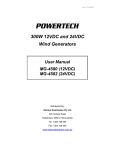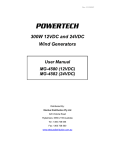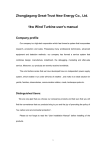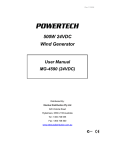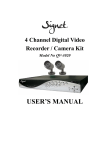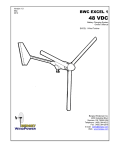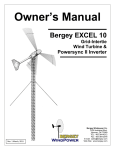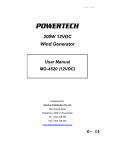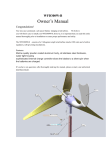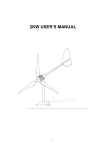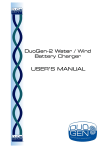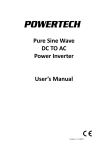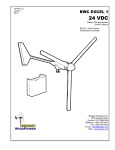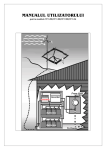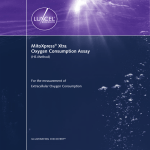Download 500W 24VDC Wind Generator
Transcript
500W 24VDC Wind Generator User Manual MG-4540 Distributed By: Electus Distribution Pty Ltd 320 Victoria Road Rydalmere, NSW 2116 Australia Tel : 1300 738 555 Fax: 1300 738 500 www.electusdistribution.com.au Table of Contents 1. Safety Precautions 3 2. Preliminary Overview 5 3. System Description 6 4. System Operation 7 5. Turbine Installation 8 6. Electrical Connections 11 7. Maintenance - Monthly 12 8. Maintenance - Yearly 12 9. Trouble Shooting 13 10. Limited Warranty 14 11. Specifications 14 -2- FD500W 24VDC 500W Wind Generator 1. Safety Precautions Please follow the instructions and recommendations in the User Manual. This will help assure safe and rewarding use of your new renewable energy system. WARNING! It is essential you read the entire contents of the User Manual prior to installation and operation. Wind generator (or wind turbine) systems present mechanical, electrical and chemical (battery) hazards that can be life threatening. The generator, tower or support structure could fall and cause injury or death and property destruction. A component of the wind generator could become loose, causing injury or death. If the wind generator is connected to a DC to AC power inverter, then high voltages from the inverter could cause injury or electrocution. A burn injury can result from an electrical short. A severe chemical burn, including blinding, can occur from a battery explosion or contact with the sulphuric acid in a lead-acid battery. -3- These conditions are addressed in the following safety messages: WARNING! It is your responsibility to obtain all required permits and engineering certifications for your tower, guy wires and tower location. Professional advice should be obtained. Soil and wind conditions vary from area to area and tower foundations, including the tower/ mast configuration, must be designed for dynamic wind loading that is specific to the area. The tower must be positioned so that it can not fall on occupied buildings, neighbour’s property or power lines. The manufacturer recommends locating the tower well away from occupied buildings and power lines ie typically 100m minimum. Tower climbing is dangerous and should only be attempted by experienced and qualified personnel using proper safety equipment. WARNING! If the generator appears to be loose or vibrate in the tower, or is making an unusual sound, the condition must be rectified immediately. A loose generator or component presents an extremely dangerous situation as it may fall from the tower. Never stand in line with a rotating propeller. WARNING! It is strongly recommended you install protection barriers to prevent unauthorized persons or children climbing the tower. Never allow an untrained person or someone without the proper safety equipment to climb the tower. Choose a calm, dry day for your installation and always stop the propeller before climbing the tower. Falling from the tower and contact with the rotating blades can be lethal. WARNING! High voltage systems (systems with an inverter) represent a dangerous shock hazard and could be lethal. All high voltage systems should be wired and maintained by a qualified and licensed electrician. WARNING! Batteries can emit dangerous and explosive gas while charging. Never turn on a light switch or any other electrical connection near a recently charged or charging a battery. Never light a match or make any type of spark near a recently charged or charging battery. Use protective gloves and eyeglasses when working with lead-acid batteries. Remove all personal metal items such as rings, bracelets, necklaces, and watches when working with lead-acid batteries. A lead-acid battery can produce short-circuit currents high enough to weld a ring or similar metal, causing a severe burn. Turn off all loads and be extremely careful when making a final battery connection. WARNING! Never place objects on top of, or near the charge controller, inverter, aurora wind interface when applicable. These devices dissipate heat and require unrestricted airflow as part of normal operation. FIRE AND FAILURE can result if airflow is blocked. WARNING! To reduce the risk of fire or electric shock, make sure the installed wiring and terminations are in good electrical condition and that all cables are appropriately sized to carry the necessary charge currents. WARNING! To reduce the risk of electric shock, do not operate the wind turbine without connecting it to an appropriate ground. Grounding procedures must be followed along with any regulatory codes. Grounding the tower is essential for lightning and static protection. Disclaimer Unless specifically agreed to in writing, we: (a) Make no warranty as to the accuracy, sufficiency or suitability of any technical or other information provided in this manual or other documentation. (b) Assume no responsibility or liability for loss or damage, whether direct, indirect, consequential or incidental, which might arise out of the use of such information. The use of any such information will be entirely at the user’s risk. -4- 2. Preliminary Overview The FD500W wind generator is a state of the art 500W alternator/ charge controller system designed to charge batteries and supply electrical power in a 24VDC system. When used in conjunction with a suitable sine wave DC to AC inverter and a battery bank, the FD500W can also provide high voltage AC for powering mains type AC appliances. The FD500W features superior low wind speed performance, very high system efficiency, and low noise. Charge Controller + Wind Generator Fuse POS + NEG 24VDC Battery Bank 2.1 What you should have with the FD500W 1 1 3 1 1 1 1 Qty 1 Tail fin Tail boom Rotor blades Alternator with output cables Hub for mounting rotor blades Nose cone Charge controller Fasteners (nuts, bolts, washers, split pins, etc) User Manual -5- 3. System Description The major components of the FD500W wind generator are shown as below. 3.1 Rotor and Blade System The rotor and blade system consists of three fibreglass blades fastened to a hub. The rotor blades convert the energy of the wind into rotational forces that drive the generator. The fibreglass blades are exceptionally strong, however, they may be damaged if they come in contact with a solid object. 3.2 Alternator The FD500W wind generator is a horizontal axis wind generator that mounts to a vertical pole/ tower. The wind generator consists of an alternator that utilizes extremely strong permanent magnets to produce electricity. The alternator produces a three-phase alternating current (AC) output which is rectified into direct current (DC) by the charge controller. Note, since the alternator uses permanent magnets, it will generate electricity/ voltage whenever the rotor is turning. 3.3 Nacelle The nacelle is the aluminium housing that surrounds the main body of the wind generator. It contains the main structural backbone of the turbine (called the mainframe), the yaw bearings, and the tower mount. The yaw bearings allow the wind turbine to freely pivot around the top of the tower so that the rotor faces the wind at all times. 3.4 Tail Assembly and AutoFurl Operation The tail assembly, which comprises a tail boom and the tail fin, keep the rotor blades aligned into the wind at wind speeds below approximately 12.5 m/s. At about 12.5 m/s the AutoFurl action turns the rotor away from the wind to limit its rotational speed. The tail appears to fold, but in reality the tail stays stationary, as the rotor/ alternator angles away from the wind. The rotor does not furl completely, as this allows the turbine to continue to produce power in high wind speeds. When the high winds subside, the AutoFurl system automatically restores the turbine to the normal unfolded or straight- configuration. -6- 3.5 Charge Controller The charge controller serves as the central connection device for the electrical components of the system. The charge controller has two primary functions: • • rectifies the AC output from the alternator into DC, and charges the battery bank The controller continually monitors the battery voltage and compares it to the regulation set point. The regulation set point is factory set to 30VDC for a 24VDC wind generator. When the battery voltage rises above the set point, it automatically stops charging the batteries. It then waits for the battery voltage to drop slightly below 22VDC before normal charging resumes. WARNING! Bad connections and terminations, undersized cables, excessive cable lengths and in-line isolation diodes (blocking diodes) will prevent the charge controller from working properly. 3.6 Battery Bank Capacity We recommend two 12V/200Ah normal lead-acid batteries for the 500W/24VDC system. 4. System Operation 4.1 Normal Operation The rotor blade assembly of the FD500W wind generator should begin to rotate when the wind speed reaches approximately 3m/s. For the first several weeks of operation, the start-up wind speed will be slightly higher because the bearing seals take a short period of time to wear in. Battery charging should commence shortly after the rotor spins up to speed. Once the rotor assembly is turning, it will continue to do so in lower wind speeds, typically down to approximately 2.5m/s. Rotor speed increases with increased wind speed. This results in the wind generator providing a higher output. The output increases rapidly because the energy available in the wind is a function of the third power (cubed power) of the wind speed. For example, if the wind speed doubles from 5m/s to 10m/s, the energy in the wind increases by a factor of eight ie 23 = 2 x 2 x 2 = 8. One disadvantage of this relationship is that there is very little energy available in light winds. For the average site, winds in the range of 5.5m/s to 12m/s will provide most of the system annual energy production. 4.2 High Winds – Autofurl During periods of high wind speeds, the AutoFurl system will automatically protect the wind turbine. When furled, the power output of the turbine will be significantly reduced. In winds between approximately 13m/s and 18m/s it is normal for the turbine to repeatedly furl, unfurl and then furl again. In winds above 18m/s the turbine should remain continuously furled. AutoFurl is a simple and elegant method of providing high wind speed protection. The AutoFurl system is based on aerodynamic forces on the rotor, gravity, and the carefully engineered geometry of the wind turbine. As shown in the following illustration, the aerodynamic forces acting on the blades cause a thrust force pushing back on the rotor. This force increases with increasing wind speeds. The thrust force acts through the centreline of the rotor, which is offset from the centreline of the tower pivot/ axis (yaw axis). Therefore, the thrust force on the rotor is always trying to push the rotor over to the side, away from the wind. -7- But the rotor blade assembly is kept facing into the wind at speeds less than 12.5m/s by the wind turbine tail assembly. The tail is kept straight by its own weight, and because the pivot at the back of the nacelle is inclined. So the weight of the tail holds it against a rubber bumper and the tail holds the rotor into the wind. The geometries in the systems are carefully balanced so that at a wind speed of 12.5m/s the rotor force acting on the yaw-offset is large enough to overcome the preset force holding the tail straight. At this point the rotor will start turning away from the wind, or furl, and the tail will stay aligned with the wind direction. The speed of furling depends on the severity of the wind gusts and whether the wind turbine stays furled depends on the wind speed. As the wind turbine furls the geometry of the tail pivot causes the tail to lift slightly. When the high winds subside, the weight of the tail assembly returns the whole turbine to the straight position. The AutoFurl system works whether the turbine is loaded or unloaded. The AutoFurl system is completely passive, and reliable since there are no wear points. WARNING! There is one situation in the field, however, that can disrupt the operation of AutoFurl. If the wind turbine is installed on a sharp hill or next to a cliff so that the wind can come up through the rotor on an incline (e.g., from below; as opposed to horizontally) it will effect furling and can produce higher peak outputs. We strongly recommend avoiding this situation. The wind generator is designed to survive in wind speeds of up to 30m/s (108km/hr). 5. Turbine Installation When installing the FD500W, exercise care at all times. The turbine weighs 15kg and ican be awkward to handle. It is best to plan the installation carefully in advance and use qualified personnel when erecting the machine and tower to avoid accidents. NOTE: Complete as much of the installation as possible at ground level. NOTE: Choose a calm, dry day for your installation. -8- The FD500W is robustly engineered, but contains high-energy permanent magnets that can be easily damaged from impacts if the machine is dropped or heavily handled. CAUTION! Make sure the turbine is disconnected from the charge controller and batteries during installation. Selection of tower and rigging materials is important. Avoid connecting different metals together ie copper and aluminium as this will create an electrochemical reaction or galvanic cell that will eventually erode one of the metals. NOTE: All external electrical cables should be protected to prevent damage from wildlife. Run all wires inside conduit for protection. Step 1: With the tower tilted down, place the powerhead of the wind turbine near the top end of the tower. Step 2: Raise the tower about 1 metre off the ground to allow space to assemble the turbine. We recommend using a temporary support stand to hold the tower up during turbine assembly. Step 3: If not already done, remove a small amount of insulation from the three generator wires. Then conduct the following electrical tests. Step 4: Now run three extension wires from the generator down inside the tower to the charge controller location before mounting the powerhead assembly to the tower. Step 5: Join the generator output wires to the extension wires running inside the tower using high current waterproof connectors or solder. If soldered, use heat-shrink tubing, self amalgamating tape or similar to insulate and protect. The connections should be waterproof to minimise the possibility of oxidation and failure. -9- Step 6: Electrically short all three extension wires at the charge controller end with a small piece of wire to prevent the generator from turning and producing power. Note: the short-circuit wire must be removed during the electrical installation stage later on. Step 7: Gently pull the three wires down through the tower, being careful not to damage or pinch the cabling. Then mount the powerhead to the top of the tower. Check the powerhead is securely mounted to the tower as is has to hold firmly in high velocity winds. Step 8: Using a torque wrench, tighten all powerhead/ tower mounting fasteners to 54Nm. Step 9: Bolt the tail fin to the tail boom. Step 10: Place the tail boom on the rear of the turbine powerhead and insert the tail pivot pin from the top. Step 11: Attach the rotor blades to the hub with the red coloured tips facing the front, or oncoming wind direction, using the M10 hardware provided. Bolt one blade up solidly and leave the other two somewhat loose ie finger tight. Step 12: Carefully slide the rotor blade assembly onto the generator shaft. Place the washers and nut on the generator shaft and tighten. Step 13: Accurately check the tip-to-tip blade distance and adjust as necessary so they are all equal. This will optimise configuration, alignment and balance of the blade assembly. Tighten all blade nuts once balanced. Step 14: Carefully place the nose cone over the hub and rotor blade assembly. Insert the screws and tighten. Step 15: Carefully raise the tower making sure not to damage the wind generator; especially the blades and rotor assembly. Secure the tower firmly with guy wires as required. - 10 - 6. Electrical Connections The general electrical configuration or setup is illustrated in the previous section. In most cases the loads will be 240VAC and will obtain power through a DC to AC power inverter. The charge controller must be installed in a waterproof cabinet or indoors, and should be located relatively close the battery bank to minimise cable losses. WARNING! Do not install the charge controller outdoors without protection; it is not waterproof. WARNING! Connect the battery first to the charge controller. Step 1: Connect the battery leads to the charge controller. First connect the negative (-) battery wire to the negative (-) terminal on the charge controller. Connect the positive (+) wire to the charge controller, then “Touch” the positive (+) terminal of the battery and withdraw quickly. If a very large spark occurs, the connections are reversed. Check wiring configuration if this occurs. Connect the positive (+) charge controller wire to the positive (+) terminal on the battery. WARNING! The user must connect batteries to the wind generator system. Without the batteries connected, the wind turbine may be damaged after some time! Step 2: Remove the shorting wire from the three extension wires. Connect the three wind turbine leads to the three terminals on the charge controller. The three wires are interchangeable and therefore are not labelled. Any leads can go to any terminal. Step 3: If the system includes a DC to AC power inverter, connect the inverter DC input leads to the battery terminals, not to the charge controller. The controller circuit board is not designed to handle the high currents that are possible when power inverters are fully loaded. Inverters can draw extremely high currents, hence the reason they should be directly and securely connected to the batteries with appropriately sized cables. Refer to suppliers recommended cable sizes. WARNING! Do not connect the wind generator directly to an inverter without batteries. The inverter will not work and may suffer permanent damage. WARNING! Do not disconnect the batteries while the inverter or wind generator are running. Permanent damage may occur. Ensure that you have the correct battery size, voltage and capacity for your system. The FD500W wind generator utilises a 24V battery system. Ensure that the batteries used are identical types and of identical age. Mixing different types/sizes/ages of battery will cause all the batteries in the bank to fail prematurely. If you need to replace batteries, you should replace all at once. WARNING! If it is necessary to disconnect the generator for some reason, do so before disconnecting the battery from the charge controller. - 11 - 7. Maintenance - Monthly 7.1 Wind Generator Check the wind generator monthly for mechanical noises, rattles, buzzes or vibration. These conditions can be damaging and should be investigated and addressed. It is essential the rotor blades are balanced and do not wobble. If the blades or the wind generator wobble it must be rectified immediately. 7.2 Tower Undertake all maintenance requirements outlined by the tower manufacturer/ supplier. Inspect the tower thoroughly including guy wires and foundations. Tighten all nuts and bolts, especially wire clips. Check for cracks, bent or broken parts and inspect the anchors and tower base structure. Check for broken strands and tighten guy wires. 7.3 Charge Controller and Batteries Consult the battery manufacturer’s maintenance guide and follow the instructions for period maintenance. Check and tighten all electrical connections on the charge controller and batteries. Remove any corrosion and protect the terminals. 8. Maintenance - Yearly 8.1 Wind Generator and Tower Lower the tower and thoroughly inspect the wind generator. Fix or replace any worn, damaged or loose parts. Check and tighten all mounting nuts and bolts. Check and tighten all rotor blade mounting bolts. Check the bearings for ‘play’. Just perceptible ’play’ is acceptable. Clean the blades with a mild detergent to remove all dirt and debris. Avoid scratching the surface. Replace rotor blades if they are cracked or damaged in any way. - 12 - 9. Trouble Shooting The following table should be used as a guide to pinpoint the cause of any operational problems. Problem Battery voltage gets too high. Cause(s) Charge controller output voltage regulation too high. Batteries do not reach full state of charge. Charge controller output voltage regulation too low. Rotor spins, but the system does not charge the batteries. Rotor is unbalanced, causing the turbine to vibrate or move back and forth as it spins. Diagnosis Excessive battery gassing. Use a precision DC voltmeter to check battery voltages. Use a hydrometer to check the specific gravity of the battery acid if applicable. Compare results to battery manufacturer’s recommendations. Battery not providing enough power. Use a precision DC voltmeter to check battery voltages. Use a hydrometer to check the specific gravity of the battery acid if applicable. Compare to battery manufacturer’s recommendations. Remedy Contact factory or distributor and replace charge controller. Cable losses too high. Check cable sizes (ie gauge size) and cable runs. Cable sizes too small or cable runs too long. This can result in excessive voltage drops. Increase cable size (ie reduce gauge) or shorten cable runs. Connector or termination losses too high Check connectors and terminations. Loose connectors and terminations can cause voltage drops, as well as localised heating. Properly secure connectors and cable terminations. Loads are too large. Remove largest load and check if the battery bank now reaches full state of charge. If so, the system was overloaded. Reduce loads Insufficient wind power Blown output fuse System not providing enough power. No remedy Remove the fuse in the charge controller and check with a multimeter Replace fuse Turbine rectifier failure, possible damaged stator winding, damaged charge controller Blade tips not evenly spaced ie blades are out of balance. Check wind generator AC output voltages to charge controller. Check DC output voltage from the charge controller with a DC voltmeter. Replace charge controller, or wind generator powerhead as necessary. Accurately check the blade tip-to-tip distances. The tip-to-tip distances should all be equal. Loosening one blade at a time, adjust the tip-totip spacing so that they are all equal. Check that the rotor blade assembly if evenly balanced. - 13 - Contact factory or distributor for repair. 10. Limited Warranty We provide free replacement cover for all defects with respect to parts and workmanship for a period of two years from the date of purchase. Our obligation is limited to replacing parts which have been promptly reported to the seller as having been in his opinion defective, and are so found by us upon inspection. Defective parts must be returned to us as soon as possible, or to an authorised agent. This warranty is void in the event of damage due to improper installation, owner neglect, blade damage resulting from flying objects, or natural disasters such as lightning, extreme winds, and does not extend to any additional devices connected to the system. This warranty is also void if any modifications are carried out on the wind generator. No responsibility is assumed for incidental or consequential damage, damage caused by the use of any unauthorised components. 11. Specifications Model No. FD500W Rated Power 500W Maximum Power 600W Rated DC Output Voltage 24V Start-up Wind Speed 3m/s Rated Wind Speed 8m/s Maximum Wind Speed 20m/s Cut-Out Wind Speed 12m/s Over Speed Protection Auto Furl Temperature Range -40 to +60 Deg. C Rotor/ Blade Diameter 2.5m Rotor speed 400rpm Blade material Fibreglass Height of tower (Recommended) Generator 6m 3 phase permanent magnet alternator Weight of turbine 15 kg - 14 -














